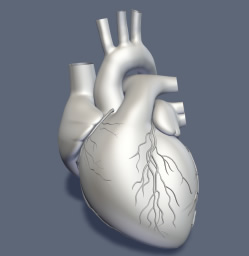MCAD Technology Drives Medical Device Development
Anatomically accurate models created by Zygote Media using SolidWorks lead to product breakthroughs for "nature's miracle pump."
Latest News
November 2, 2007
By David Dunston and Mari Truman
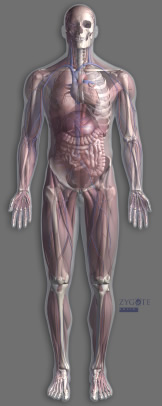 Zygote is in the process of developing a Zygote Zygote is in the process of developing a ZygoteSolid model of the entire human anatomy — including bones, organs, arteries, nerves, skin,and muscle tissue — providing design engineers with templates for a wide range ofbiomedical research and product development. |
Until recently, the purpose for almost all of the anatomical modeling performed at Zygote Media was to produce graphics, visuals, and animations that were entertainment or education related, such as the models the company produced for use in movies (Hollow Man), on television networks (The Discovery Channel), and in textbooks and educational software. Today, however, Zygote is experiencing increased demand for actual anatomical 3D CAD models to function as blueprints from which medical-device companies can develop products and technologies that can save and extend lives and improve patient quality of life.
Instead of relying solely on cadavers and 2D magnetic resonance imaging (MRI) and computer tomography (CT) scan data as reference points for designing products, manufacturers are now beginning the development process by acquiring information-rich 3D CAD models of soft-tissue organs like the heart. This approach enables designers and researchers to add intelligence to the model, not only to better simulate conditions within the body but also to customize treatments for specific patient needs. Recent customer demands for more complex soft-tissue models of vital internal organs prompted the company to acquire SolidWorks 3D CAD software to produce anatomical solid models and help manufacturers design better products.
Creating an Anatomically Accurate Heart Model
Producing an accurate 3D CAD model of a human heart presents unique challenges due to the organ’s geometric complexity, both internally and externally, as well as the intricacies involved in modeling muscle tissue, valves, and vessels. Because Zygote licenses its anatomical models to companies that use a variety of different MCAD systems, it chose SolidWorks because it can handle advanced surfacing and geometric modeling, supports a large user base among medical manufacturers, and can output models in a variety of MCAD file formats.
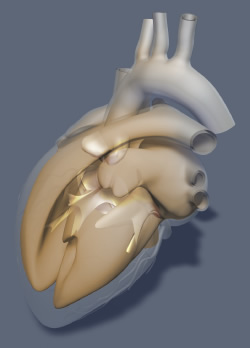 The Zygote solid model of the heart accurately depicts interior surfaces,including valves, enabling more precise medical-device manufacturing. The Zygote solid model of the heart accurately depicts interior surfaces,including valves, enabling more precise medical-device manufacturing. |
|
Initially, the company scanned an actual medical model of a heart with a MicroScribe arm. Since the interior was difficult to digitize, a 3D anatomy specialist helped clean up and refine the model. This data was then used to build detailed, high-quality IGES surfaces that correspond to different regions of the heart, including the ventricles, atria, valves, veins, and arteries. The surfaces were gathered in Alias software. Zygote engineers imported all of these individual surfaces into SolidWorks software, which provides an efficient interface for merging, editing, and manipulating the multiple IGES surfaces, to create an anatomically accurate human heart model. Now CT scan data is used on all new Zygote models. The data is imported and refined, and new surfaces and stitching are completed SolidWorks.
It’s important to recognize that the Zygote model represents a starting point from which manufacturers develop more sophisticated heart models that take anthropomorphic and individual anatomical variances into account, as well as imbue the model with additional intelligence.
The overarching benefit of creating the heart model in a parametric MCAD system like SolidWorks rests in the flexibility the technology provides for evolving and morphing the template for a specific and unique purpose.
Morphing the Heart Template
The ultimate value of a parametric MCAD model of a human heart for cardiac product developers is the ability it provides for representing and simulating the heart’s complex multiphysics behavior and seemingly endless variety. No two human hearts are the same, and the conditions of interest for a particular product manufacturer can also vary. A stent manufacturer, for example, focuses on the vascular region and the heart-arterial interface, while a developer of implantable cardiovertor defibrillators (ICDs), which sense cardiac rhythm and use electrical shocks to pace the heart as needed, concentrates on the heart’s electrical conductivity. Similarly, artificial valve manufacturers study blood flow.
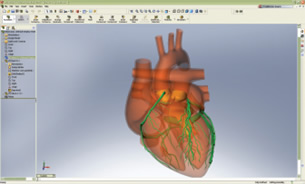 Access to an accurate Zygote solid model of the human heart provides design engineers with an MCAD template, which they can use to develop products such as heart pumps, stents, pacemakers,implantable defibrillators, catheters, heart-tissue valves, and vascular closure and suturing devices. Access to an accurate Zygote solid model of the human heart provides design engineers with an MCAD template, which they can use to develop products such as heart pumps, stents, pacemakers,implantable defibrillators, catheters, heart-tissue valves, and vascular closure and suturing devices. |
By using a parametric 3D CAD model, researchers and product developers can use actual patient scan data (MRI and CT) to morph and evolve the heart to match a specific patient heart or to represent a more generalized group. Using the Zygote heart template, engineers can also modulate material properties and multiple strain rates to simulate heart-muscle contraction properties accurately, conduct computational fluid dynamics (CFD) studies of blood flow, or perform other types of complex analyses. The Zygote model provides the initial reference point from which manufacturers can morph the heart model to meet their unique analysis and design requirements.
A multitude of cardiac applications
Zygote Media has licensed its heart MCAD model for use by four manufacturers of cardiac-related products that are currently in patient trials or on the market. One of these licensees, HeartWare, Inc. of Sydney, Australia, is developing a family of left ventricular assist devices (LVADs), which are miniaturized continuous-flow heart pumps for the treatment of advanced heart failure. HeartWare’s HVAD System, which is currently the subject of international clinical trials, suspends the pump’s impeller through the use of a combination of passive magnets and a hydrodynamic thrust bearing, resulting in a system that is completely “wearless.”
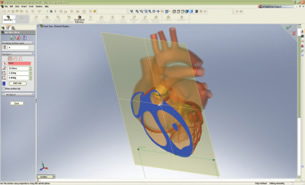 With a Zygote Media solid model of the human heart, design engineers can use the power of a 3D CAD system like SolidWorks to visualize internal features easily, using tools such as the crosssectioningplane shown here. With a Zygote Media solid model of the human heart, design engineers can use the power of a 3D CAD system like SolidWorks to visualize internal features easily, using tools such as the crosssectioningplane shown here. |
Another Zygote licensee, the Gore Medical Products Division of W.L. Gore & Associates of Newark, DE, produces cardiothoracic products, such as the GORE-TEX ACUSEAL Cardiovascular Patch, which uses advanced fluoropolymer technology to “seal” around penetrating sutures and decrease suture line bleeding. Sutura, Inc. of Fountain Valley, CA, a manufacturer of minimally invasive suture placement devices for use during cardiac catheterizations, has licensed the Zygote model, as has St. Jude Medical of St. Paul, MN, a manufacturer of a variety of cardiac devices, including ICDs, pacemakers, catheters, vascular closure devices, and heart-tissue valves (both stented and unstented).
The use of 3D CAD models of soft-tissue organs like the heart for research and product development is still in its infancy. But as solid modeling and surfacing technology continue to advance, along with easier-to-use, integrated multiphysics simulation tools, more and more manufacturers will realize the benefits of using MCAD technology to drive medical device development.
By transforming templates like the Zygote heart model into sophisticated, intelligent heart models, researchers and designers will not only gain a greater understanding of how nature’s miracle pump functions, but will also be able to develop the product innovations and technologies that can provide hope, comfort, and life to the thousands of people suffering from heart disease around the world.
More Information:
Alias
Autodesk, Inc.
San Rafael, CA
autodesk.com
W.L. Gore & Associates
Newark, DE
gore.com
HeartWare, Inc.
Sydney, Australia
heartware.com.au
MicroScribe
Immersion
Lindon, UT
immersion.com
SolidWorks
Concord, MA
solidworks.com
Zygote Media
Lindon, UT
zygote.com
David Dunston is executive partner and designer at Zygote Media, Inc. and Mari Truman is principal engineer at Zygote Media, Inc. To comment on this article, send e-mail to DE-Editorsmailto:[email protected].
Subscribe to our FREE magazine, FREE email newsletters or both!
Latest News
About the Author
DE’s editors contribute news and new product announcements to Digital Engineering.
Press releases may be sent to them via [email protected].







